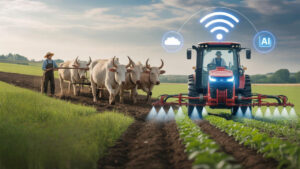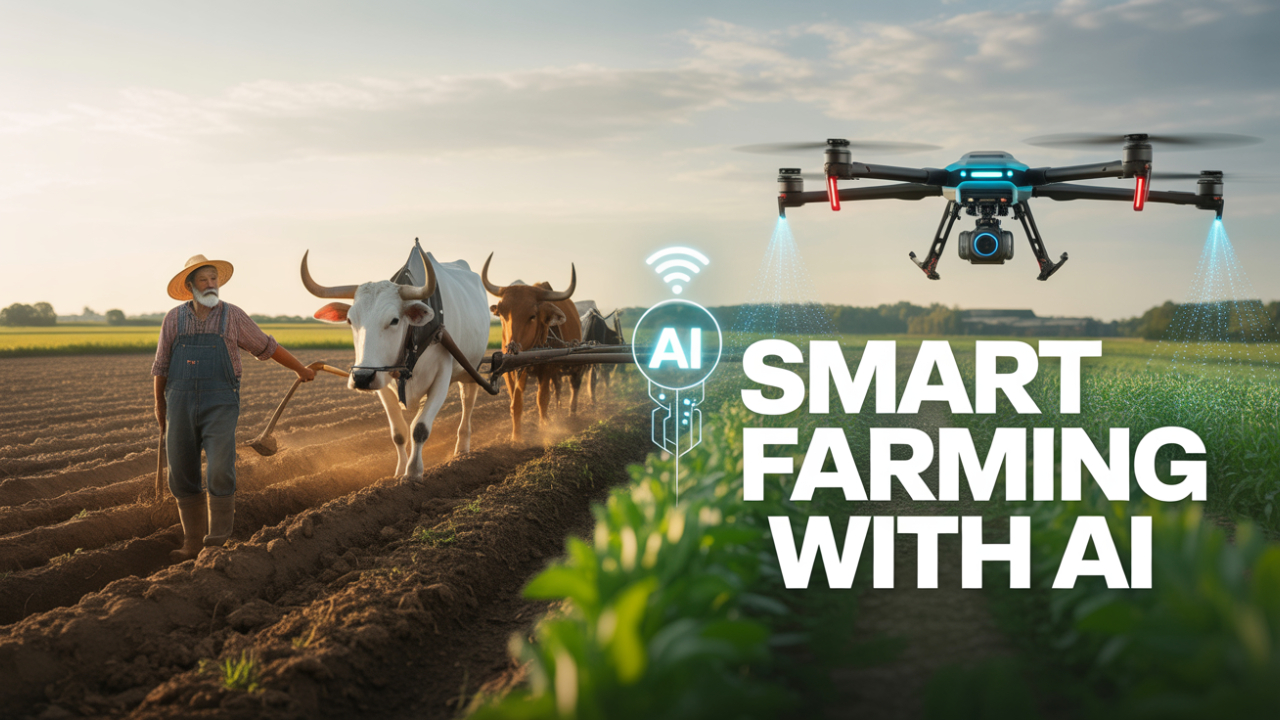Agriculture is the backbone of many economies, especially in countries like India where over 50% of the population depends on it for livelihood. However, modern challenges like climate change, water scarcity, unpredictable weather, and labor shortages have pushed farmers to seek smarter, more sustainable solutions. This is where Artificial Intelligence (AI) is stepping in.
1. Precision Farming with AI
One of the most significant impacts of AI in agriculture is precision farming — the practice of using technology to monitor and optimize field-level management.
How AI Helps:
-
Satellite imaging and drones provide real-time data on soil health, moisture levels, and crop growth.
-
AI algorithms analyze this data to identify areas needing water, fertilizer, or pesticides.
-
Farmers can target specific zones in the field, reducing input costs and maximizing output.
This leads to:
-
Higher crop yields
-
Less environmental damage
-
Efficient use of resources
Example: AI-powered systems like IBM’s Watson Decision Platform help farmers understand exactly what their crops need — and when.
2. AI-Powered Crop and Soil Monitoring
Healthy soil is the foundation of good agriculture. AI now enables farmers to track soil conditions in real time through sensors and predictive models.
Key Features:
-
Soil health prediction through image processing
-
AI models that analyze NPK levels (Nitrogen, Phosphorus, Potassium)
-
Sensors embedded in soil to check pH, moisture, and nutrient levels
-
Recommends best crop rotation and fertilizer usage
This allows for early detection of problems, better planning, and overall soil conservation — essential for long-term sustainability.

3. Weather Forecasting and Risk Management
Weather is the most unpredictable variable in agriculture. With AI, farmers can now access hyper-local weather forecasts and receive actionable insights in real time.
AI in Weather Analysis:
-
Predicts rainfall patterns, droughts, frost, and storms
-
Sends early warnings to protect crops
-
Helps in planning irrigation, sowing, and harvesting schedules
Result: Reduced risk of crop failure and more informed decision-making.
Example: Indian startups like Skymet use AI to deliver real-time weather updates tailored for farmers in local languages.
4. Crop Disease and Pest Detection
Pests and plant diseases can destroy entire harvests if not treated in time. AI now helps farmers detect plant stress early, before the human eye can spot it.
Technologies Involved:
-
Computer Vision: Drones and mobile apps analyze crop images
-
Machine Learning: Models identify patterns linked to disease or pest attack
-
Smart Alerts: Notifies farmers via app or SMS
This leads to:
-
Timely pesticide use
-
Reduced chemical application
-
Healthier crops and soil
Example: Microsoft’s AI Sowing App in partnership with ICRISAT helps farmers in India make accurate decisions about sowing and pest control.
5. Smart Irrigation Systems
Water is one of the most critical and limited resources in agriculture. AI-powered irrigation systems use real-time data and automation to deliver water only where and when it’s needed.
Features:
-
Soil moisture sensors and weather data integration
-
Predictive watering schedules
-
Mobile app controls
These systems help reduce overwatering and underwatering, cutting water usage by up to 30–40% in some cases.
Example: AI-driven drip irrigation systems by Netafim and CropX help farmers automate and optimize water usage.
6. Yield Prediction and Crop Planning
Farmers can now predict crop yields before harvesting, helping them plan sales, storage, and market prices in advance.
How It Works:
-
AI models analyze past weather, soil, and crop data
-
Predicts expected yield with high accuracy
-
Helps plan which crop to plant next season based on soil and market conditions
This minimizes uncertainty and helps farmers increase profitability.
Example: Startups like AgNext and Intello Labs are using AI for food quality assessment and yield forecasting.
7. Autonomous Farming and Robotics
AI is also powering a new generation of autonomous farm equipment such as:
-
Self-driving tractors
-
AI-guided harvesters
-
Weed-removal robots
-
Automated seed planters
These machines use computer vision and GPS to operate efficiently without human intervention — reducing the need for labor and increasing accuracy.
Benefit: Lower labor costs, better efficiency, and 24×7 operations.
8. Supply Chain and Market Insights
Beyond the field, AI also helps farmers and agribusinesses streamline supply chains and make smarter marketing decisions.
Features:
-
Price prediction tools for crops in different mandis
-
Storage and transportation optimization
-
Demand forecasting based on market trends and weather
AI enables direct farmer-to-consumer selling models, helping eliminate middlemen and boosting farmer income.
9. AI Chatbots and Mobile Apps for Farmers
Many agri-tech companies now offer AI-based chatbots in local languages to guide farmers on:
-
Weather alerts
-
Crop advisories
-
Fertilizer schedules
-
Government schemes and subsidies
These bots are accessible via smartphones, SMS, or WhatsApp, making technology available to even small farmers.
Example: KisanGPT, BharatAgri, and Gramophone are apps empowering Indian farmers with AI-driven insights.
10. Government and Startup Support
The Indian government and various agri-tech startups are actively promoting the use of AI in agriculture.
Key Initiatives:
-
Digital India and PM-KISAN programs integrating AI tools
-
ICAR and IIT collaborations for AI research
-
Government-approved platforms like eNAM for digital agri-marketing
With increasing internet and smartphone penetration in rural areas, AI is becoming more accessible and affordable.
Challenges to AI Adoption in Agriculture
Despite its potential, some barriers still remain:
-
Lack of digital literacy among small farmers
-
Initial high cost of equipment
-
Internet and electricity access in rural zones
-
Language and app usability issues
However, with targeted training and government support, these gaps are slowly narrowing.
Conclusion: The Future of Farming is AI-Driven
AI in agriculture is no longer science fiction — it’s today’s reality. From increasing yields and reducing costs to protecting the environment, AI offers powerful solutions to the age-old problems faced by farmers.
In 2025 and beyond, the focus will be on making AI tools more affordable, accessible, and farmer-friendly. With more startups entering the agri-tech space and increasing support from policymakers, the future of agriculture is not just green — it’s smart.
Disclaimer
This blog is for informational purposes only. AI solutions vary based on region, crops, and technology providers. Farmers are advised to consult agricultural experts before implementing AI-based solutions.

1 thought on “AI in Agriculture: The Future of Farming”